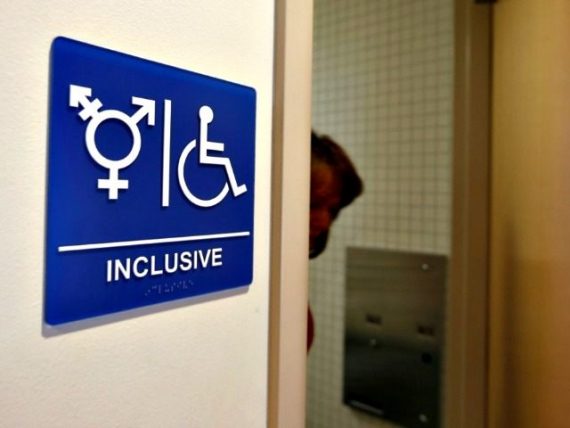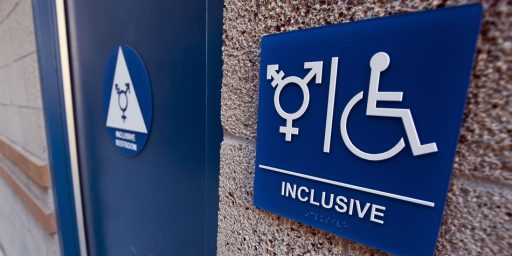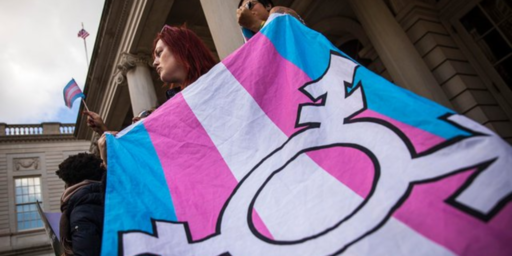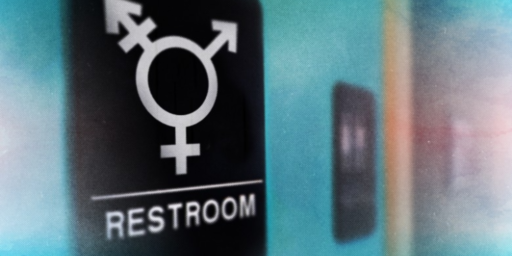Federal Judge Sides With Transgender Student In Bathroom Access Case
Another Federal Court has ruled in favor of a student seeking to use the restroom facilities that correspond with their gender identity.
A Federal District Court Judge in Maryland has ruled that a Maryland school district’s effort to bar a transgender student who identifies as male from using the boy’s bathroom violates Federal anti-discrimination laws as well as the Equal Protection Clause of the Fourteenth Amendment and certain provisions of Maryland’s Constitution
A Maryland high school’s policy blocking a transgender student from using the boys’ locker room singles him out for discrimination and “harms his health and well-being,” a federal judge in Baltimore has ruled.
Max Brennan, a transgender teen from the Eastern Shore, was required to use a separate, gender-neutral restroom to dress for gym class, making him choose at times between being late or being penalized for not changing.
U.S. District Judge George L. Russell III is the latest judge, and the first in Maryland, to find that the right of a transgender student to use restrooms and locker rooms matching his or her gender identity is protected by federal and state law.
The policy barring Brennan from the boys’ locker room “does not apply to anyone else at the high school, and marks him as different for being transgender,” the judge wrote in a 40-page opinion issued this week that allows Brennan’s lawsuit to move forward.
In a statement, Brennan, a 15-year-old who attends St. Michaels Middle High School, called the decision a “great step in the right direction.”
The decision comes after the Trump administration last year abandoned Obama administration guidelines that directed public schools to accommodate transgender students. The Supreme Court last March put off ruling in the separate case of Virginia transgender teen Gavin Grimm, delaying a decision about whether federal laws forbidding discrimination on the basis of sex also extend to gender identity.
In his opinion, published Monday, Russell said that in addition to the Equal Protection Clause of the U.S. Constitution, Maryland’s constitution prohibits public schools from excluding transgender students from using the same facilities as their non-transgender classmates.
“I am hopeful that this case will not only help change policy for the better but help the students who are bound to come after me,” Brennan said.
His attorney, Jennifer Kent of FreeState Justice, said, “School systems in Maryland should know the law and should be protecting students who are transgender from discrimination, not singling them out for separate and unequal treatment.”
Debbie Gardner, a spokeswoman for the Talbot County Public Schools, the district to which St. Michaels belongs, said she could not comment because of the litigation.
(…)
Initially, Brennan’s school required him to use one of three “gender neutral” restrooms. After the 4th Circuit ruling, the school allowed him to use the boys’ restrooms but prevented him from using the boys’ locker rooms. The designated restroom was far away from the locker room, according to court filings, making Brennan late for class if he wanted to change to gym clothes.
Attorneys for the school board said the policy does not violate the Equal Protection Clause because it treated Brennan like every other student, requiring him to use the locker room of his birth sex. The school system also raised concerns about the privacy of other students changing in the locker room with Brennan.
Russell disagreed. The judge cited Brennan’s assertion the locker rooms have individual stalls for changing and for toilets.
Brennan has had to disclose his transgender status to substitute teachers to avoid being penalized for arriving late to gym class, and his grade suffered when he did not change clothes for gym class because he “did not want to deal with the ‘stigma and impracticality’ of changing in the designated restroom,” Russell wrote.
As a preliminary matter, Judge Russell found that the school board’s policy constituted discrimination based on sex as barred by both Title VII of the Civil Rights Act of 1964 and the provisions of the amendments to that law that were passed by Congress in the early 1970s and most commonly known as Title IX. This, of course, is basically the same argument that the Education Department and the Justice Department took under the Obama Administration which caused the two departments to issue guidelines to America’s public schools stating that they must accommodate transgender students by allowing them to use the bathroom or locker room that corresponded to the gender they identified with. As I noted at the time, the legal basis for these guidelines was not entirely solid and that some Federal Courts had ruled against parties making such an argument while others had ruled in favor of it. Not surprisingly, the Trump Administration rescinded those guidelines shortly after the President took office and the Department of Education has announced that it will not investigate complaints filed by transgender students over access to the bathroom for the gender they identify with.
In his ruling, Judge Russell effectively adopts the same legal arguments that the Obama Administration made in its 2016 guidelines, finding that discrimination against transgender students effectively qualifies as discrimination based on “sex,” which is barred by both Title VII of the Civil Rights Act and by Title IX. The problem with that argument, of course, is that it seems fairly obvious that discrimination based on gender identity was not within the contemplation of the drafters of either law or the legislators who voted in favor of them. Additionally, neither law explicitly mentions transgender rights or transgender rights or protections for transgender individuals and there is is no evidence in the Congressional Record that indicates that Congress contemplated that the laws would be applied in situations such as this. At the same time, though, it’s worth noting that both the Fourth Circuit Court of Appeals and the Seventh Circuit Court of Appeals have accepted the argument and ruled in favor of transgender students. Eventually, though, this question will have to be decided by the Supreme Court.
In addition to ruling in the student’s favor on the statutory claims noted above, Judge Russell also ruled that the Talbot County’s bathroom policy violated the Equal Protection Clause of the Fourteenth Amendment. This mirrors the ruling that the Seventh Circuit handed down last year, and is the second time that I’m aware of that a Federal Court has explicitly found that discrimination based on the fact that an individual is transgendered is barred on equal protection grounds. As I explained in my post earlier this month on the lawsuit that the N.R.A. filed regarding Florida’s new law barring gun sales to anyone under 21, claims under this provision of the Constitution are evaluated based on differing levels of scrutiny. In this case, Judge Russell held that discrimination based on gender identity must be judged based on so-called “heightened” or “intermediate” scrutiny, meaning that the jurisdiction defending the law being challenged must show that it furthers an important government interest by means that are substantially related to that interest. Based on that standard, Russell found that the school board’s bathroom policy could not pass muster:
As mentioned above, sex-based classifications require an intermediate form of heightened scrutiny, which requires the state to show that the justification for the classification is “exceedingly persuasive.” Virginia, 518 U.S. at 533. An exceedingly persuasive justification requires the state to demonstrate that the “classification serves important governmental objectives and that the discriminatory means employed are substantially related to the achievement of those objectives.” Virginia, 518 U.S. at 533 (quoting Miss. Univ. for Women v. Hogan, 458 U.S. 718, 724 (1982)) (internal quotation marks omitted). “The justification must be genuine,” and one that is “hypothesized or invented post hoc in response to litigation” is not sufficient. Id. at 533. Nor can the justification rely on “overbroad generalizations about the different talents, capacities, or preferences of males and females.” Id.
The Seventh Circuit in Whitaker is the only United States Courts of Appeals that has addressed whether a policy that denies transgender students access to the sex segregated facility that aligns with their gender identity violates the Equal Protection Clause. There, the defendant school district defended its policy by first arguing that the policy does not implicate the Equal Protection Clause because it treats all boys and girls the same. Whitaker, 858 F.3d at 1051. It further asserted that the policy is necessary to protect the privacy rights of all of the district’s students. Id. at 1052. The court rejected both arguments. Id. at 1051, 1052.
Whitaker held that the school district’s contention that “it treats all boys and girls the same” is “untrue.” Id. at 1051. Under the policy, if transgender students choose to use a bathroom that aligns with their gender identity, the school district disciplines them.Id. As a result, the policy implicates the Equal Protection Clause. Id. at 1051-52. In assessing the plaintiff student’s likelihood of success on the merits of his claim under intermediate scrutiny, Whitaker held that the record demonstrated that the school district’s privacy justification, though “legitimate,” was not “genuine” because it was ”based upon sheer conjecture and abstraction.” Id. at 1052. The court highlighted that the student used the boys restrooms without “incident or complaint” from other students.Id.
(…)
The Policy clearly implicates the Equal Protection Clause. It treats M.A.B.differently from the rest of the High School’s students. While the rest of M.A.B.’s peers may use the locker room that aligns with their gender identity, M.A.B. may not. Instead, Defendants discipline M.A.B. if he uses such a locker room—the boys’ locker room. As a matter of fact, his physical education teacher penalized his grade when M.A.B. did not change his clothes because he did not want to deal with the “stigma and impracticality” of changing in the designated restrooms. (Compl. ¶ 42). Also, M.A.B. had to disclose
his transgender status to substitute teachers to avoid disciplinary action for being late to class after changing in those distant restrooms. (Id. ¶ 41). None of these events would occur if the Policy permitted M.A.B. to change in the locker room that aligns with his gender identity, like the rest of the students at the High School. Thus, the Policy implicates the Equal Protection Clause.
The Court concludes that the Policy does not withstand intermediate scrutiny because, as alleged, it is not substantially related to the privacy rights Defendants raise. To be sure, Whitaker and the Fourth Circuit in Grimm I both acknowledged that bodily privacy is a “legitimate and important interest.” Grimm I, 822 F.3d at 723; see also Whitaker, 858 F.3d at 1052 (recognizing that the school district “has a legitimate interest in ensuring bathroom privacy rights are protected”). M.A.B. highlights that Defendants have not offered a factual basis to support their privacy concerns. But on a motion to dismiss, the Court may only consider M.A.B.’s allegations in the Complaint and accept them as true. Albright, 510 U.S. at 268; Lambeth, 407 F.3d at 268 (citing Scheuer, 416 U.S. at 236). M.A.B. does not describe the basis of Defendants’ privacy concerns in his Complaint. Unlike in Whitaker, where the court had the benefit of a
factual record from which to conclude that the school district’s privacy concerns were not ”genuine,” in this case there is not yet a factual record.The Court need not assess whether the privacy concerns Defendants raise are sufficiently “important governmental objectives,” however. See Virginia, 518 U.S. at 524. Even assuming they are, the Court concludes that the Policy, as alleged, is not ”substantially related” to those asserted privacy rights. See id.
Along with the Seventh Circuit decision I noted above this case is unique in that it is among the first times that a Federal Court has held that discrimination based on transgender status is entitled to heightened scrutiny protection under the Equal Protection Clause and that could be significant on appeal. For example, while Judge Russell, like the Seventh Circuit, does group discrimination against transgender under student under rubric of “gender” discrimination, that analysis doesn’t carry with it the same potential problems as it faces under a Title IX analysis. This is due to the fact that the Equal Protection Clause does not mention any particular categories to which it applies, largely because it’s clear that the drafters of the Fourteenth Amendment intended for it cover all Americans rather than just the issue of racial discrimination that was the primary concern in the post-Civil War context in which it was enacted. Over the years, the Courts have ruled that the clause applies far beyond just the issue of race-based discrimination and covers nearly any kind of difference between people that may be treated differently under the law. Because of this, the Court’s analysis under this theory appears to have a stronger likelihood of being upheld on appeal.
Assuming that the school board in this case decides to appeal, of course, that appeal would go to the Fourth Circuit Court of Appeals which, of course, has already ruled in favor of the rights of transgender students in a ruling arising out of a Virginia case. Given that, it seems likely that the case would withstand scrutiny on at least its first round of appeal. Because of this, though, the school board could decide the forego an appeal and comply with the Courts ruling. Whichever way it goes, though, this is another significant legal development in favor of transgender rights and another sign that, eventually, this issue will have to be addressed by the nation’s highest court.
Here’s the opinion:
M.A.B. v. Board of Education of Talbot County by Doug Mataconis on Scribd






I think these decisions are right in terms of policy but absurd judicially. Rather obviously, the people who wrote and passed the Civil Rights Act of 1964 were not trying to gender integrate bathrooms. As recently as four or five years ago, that would have been viewed as a laughable notion. Now, suddenly, courts are finding a new right in half-century-old legislation. That’s not the job of judges.
@James Joyner:
I tend to agree with regard to the statutory claims.
The Equal Protection argument is on a different level. In his opinion Judge Russell makes out a compelling argument for why transgender individuals should be treated as what the law considers a “suspect” class, meaning that laws which discriminate based on that class need to be justified based on a higher level of scrutiny than a mere rational basis test.
@James Joyner: These Federal judges have their own private restrooms to use. They should not be telling the people how to run their restrooms. If I own a business, it is up to me if I want to make restrooms available, and to have a set of rules for usage.
Most women I know will not use the men’s room unless it is some emergency. And even then they wipe down the toilet seat and handles thoroughly.
Men should use the men’s room. Women should use the women’s restroom. That is the way it has always been. There is no confusion about that.
Signs in restrooms:
“Fixtures installed by Bill Johnwater Plumbing Contractor”
“Restroom cleaned and maintained by Plushbottoms Maintenance”
“This restroom inspected by Fred Philpott, county health inspector”
Read – “Under the Stalls” by Seymore Butz
@James Joyner:
Um, neither is this judge, James. The bathroom is for males, and only males are using it.
That’s actually a pretty revealing tell on your part.
Of course, the importance of “framer’s intent” is also not quite as overwhelming as you seem to be asserting, at least not for the past century or so… but that’s a different argument.
Actually, whether or not you make your restroom available to customers is most often prescribed by local laws. Try opening a 20 table restaurant and explaining to your county that you aren’t providing restrooms. So, no, it’s not just up to you any more than it’s up to you whether you serve black customers.
And since allowing transgender access to restrooms in many parts of the country, the incidence of rape or serious mis-behavior by a male-to-female person in a ladies room remains: zero.
This is the kind of thing that’s actually more complicated in the abstract than it is in reality. Because in reality it’s already happening and causing no problem.
@michael reynolds:
Indeed. Statistically, I am far safer going into a restroom with a trans woman than I am with the men who seek to force her to use the men’s restroom.